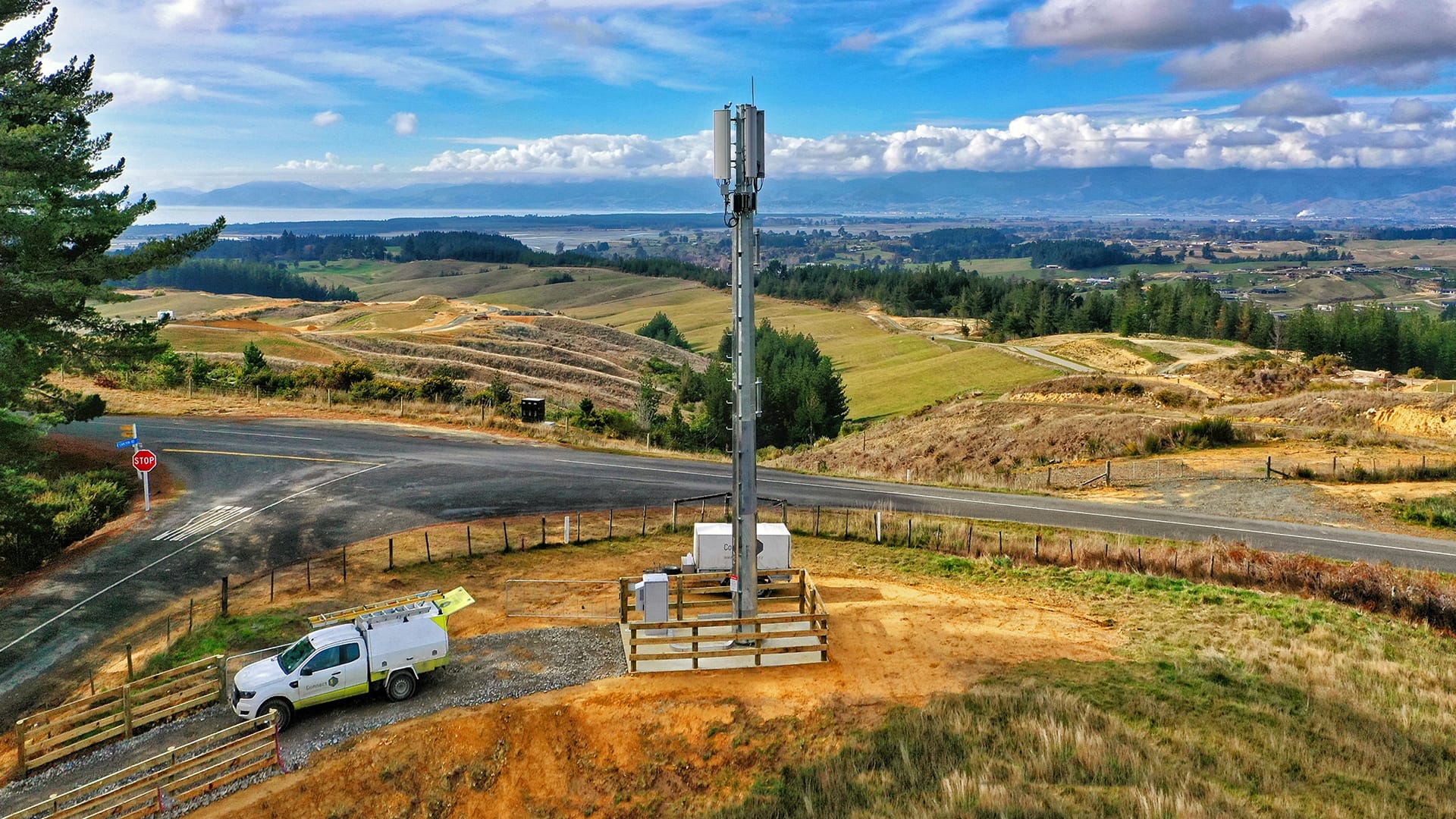Spark buys Lauriston solar farm output

Telco signs 10 year renewable energy deal with Genesis
A 10 year deal between Spark and Genesis Energy will see the telco buy all the power generated by the Lauriston solar plant.
Spark says this will make a significant contribution towards its emissions reduction target. It aims to cut Scope 1 and 2 emissions by 56 per cent when measured against its 2020 level.
Construction work is about to start at Lauriston. When the plant goes online at the end of this year it has a planned output of 63MW. Spark says that is around 60 per cent of its total energy requirement.
For now Spark plans to get the rest of its power from Genesis through the grid. The two companies say they plan to explore further low or zero emission opportunities as Spark aims to move to 100 per renewable energy in the longer term.
Spark aims for emissionless growth
Jolie Hodson, Spark’s CEO, says she expects her company’s energy use to increase as it invests more in data centres and 5G mobile infrastructure.
She says the company has been exploring how to decouple growth from emissions growth: “It is important to us that we deliver on our science-based target by supporting the generation of new renewable energy.
“In doing so I believe we are demonstrating how NZ Inc can work together to support Aotearoa’s climate goals – with Spark's procurement supporting Genesis’s renewable energy investments, and those investments in turn enabling Spark to meet its emissions reduction targets.”
Hodson is the convenor of the Climate Leaders Coalition, a group of New Zealand business leaders who banded together for a collective response to climate change.
One NZ tail wags for Infratil’s dog
One New Zealand played a starring role in Infratil’s 2024 financial results.
The telco saw its proportionate EBITDAF, that’s earnings before interest and taxation, depreciation and amortisation and fair value adjustments, up 63 per cent on last year.
Infratil says while most of the gain comes from doubling its stake in One New Zealand during the year, it would have still climbed 15 per cent without that transaction.
Mobile growth
One NZ saw its EBITDAF up 13.7 per cent at $600 million. It says much of the growth came from mobile operations. One invested $70 million in building an additional 346 mobile sites during the year and expanded its fibre network. It says it will establish a separate fibre business during the current financial year.
Other Infratil highlights include a 26 per cent EBITDAF increase for the CDC data centre business. The year saw additional capacity added at sites in Silverdale and Hobsonville, which a second data centre is now being built at Hobsonville.
Infratil’s New Zealand mobile tower business, Fortysouth, which run the towers for One NZ, added 48 new sites and upgraded 247 during the year.

Greer takes chief customer role at 2degrees
2degrees chief corporate affairs officer Emma-Kate Greer has moved to take over the chief customer officer role at the telco. Her job involves overseeing the 700 employees in the company’s customer operations. It also means taking control of 54 retail stores, along with channels and customer support.
Greer will be known to many in the industry following from her time at Telecom, now Spark. She has also worked for Genesis and TVNZ.
She will replace Taryn Hamilton who has moved on after 10 yers with the company.

Crown Infrastructure Partners says more rural upgrades to come despite reaching the target
Crown Infrastructure Partners’ Quarterly Connectivity Update reports that, a startlingly precise 84,104 rural households and businesses now have access to improved broadband.
CIP says that while this figure represents 100 per cent of the figure that was originally targeted by the Rural Broadband Programme, it doesn’t mean the project is over. It says “There are a number of contracts that are yet to conclude”. In other words, it appears the programme is set to go past its target.
Other highlights from the update include a further 66km of State Highways covered during the first three months of the year. This brings the total to 1,471km. The project to provide coverage at tourism spots is not 85 per cent complete with 10 additional spots covered during the quarter.
Reseller News: Local fibre network operators seek to go 'beyond fibre'
Rob O’Neill turned in a 700 word story looking at the future facing the local fibre companies. He writes:
“A discussion document released by the the Ministry of Business, Innovation and Employment (MBIE) earlier this month said with the completion of phases one and two of the of the Ultrafast Broadband project, LFCs had raised questions about their role in telecommunications markets and restrictions in their constitutions.
“The LFCs are Enable, Tuatahi First Fibre and Northpower Fibre, all of which have rolled fibre out within specified geographic areas while Chorus did the same for the rest of the country.
“Where Chorus was regulated, the LFCs were restricted in their activities, such as providing retail services, through their constitutions.
“We understand the other LFCs consider that the settings in their constitutions are too restrictive and prevent them from expanding their networks and developing services for consumers (which could contribute to addressing existing connectivity challenges, including in rural areas),” the discussion document said.
What’s clear is the competitive landscape has altered since the rules were established at the start of the UFB fibre build some 15 years ago. At that time fibre looked like it could be a monopoly.
Today those rules look too restrictive, but it’s an area where government decision makers and regulators tend to move slowly, especially so when compared to the pace of change in the wider communications market.
In other news...
Brennan Doherty, writing for the BBC website, says: People want dumb phones. Apparently handsets with fewer features are hard to find and phone makers simply aren’t interested in serving customers who prefer to do less with their mobiles.
You sometimes hear these devices referred to as ‘feature phones’. That is ridiculous. The whole point of the hardware is their lack of features.
Another ridiculous idea is that the new Arm-powered, AI-enabled Windows laptops that hit the streets this week pose a direct challenge to Apple.
Almost no-one decides between Windows and MacOS because of the processor inside the computer. If they did, Apple would have dominated hardware dales for the past three years with its processors massively outgunning the CPUs in Windows laptops. See also: The bigger story as Microsoft introduces Copilot+ PCs.
NZ Compare thinks New Zealanders pay too much for broadband. It’s certainly true that local prices don’t compare favourably with other markets. If there are problems, they are structural. New Zealand lacks scale and has a widely dispersed population. There’s also a counter argument that our service providers and wholesalers are not making huge profits. If you are signed up for the newsletter you can comment on this below.
At Interest, Juha Saarinen says Starlink has demonstrated a video call directly to a standard mobile phone. It looks like the satellite network will be ready for One New Zealand’s planned launch of text services later this year. There’s no indication of pricing yet.
At the ITP Tech Blog Peter Griffin’s The stark contrast between Aussie’s innovation-heavy budget and our own makes a valid point. He says he admires that country’s chutzpah when it comes to its huge investment in quantum computing. One aspect of the story not covered is the Australian government’s long term success rate when placing bets on technology. Not every past investment has paid off.
It’s behind the paywall, but at BusinessDesk, Ben Moore writes about Dawn Aerospace. The business, co-founded by Kiwis Stefan and James Powell, promises a greener approach to putting satellites in orbit.
Things are far from happy at Christchurch City Council’s holdings company, CCHL, which controls the Enable Services fibre business. At Newsroom, David Williams picks apart the rows which resulted in the sudden resignation of four board members.
Member discussion